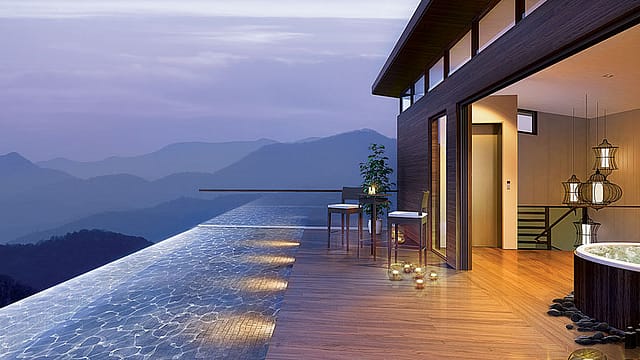At home in the Himalayas
ADVERTISEMENT

INDIAN REAL ESTATE is on a high, literally.
Some of it rubs off on me as I walk the grounds of Myst by Tata Housing, an under-construction gated community at Kalth Ridge in Himachal Pradesh’s Kasauli district—barely 65 km from Chandigarh—which, when completed, will have 48 apartments, 28 villas, a club, a spa, a swimming pool, an entertainment area, and a helipad. However, it’s not the proximity to the big city, or the frills, that drive Myst’s vertiginous Rs 3.35 crore to Rs 8 crore-plus price points. Located in the foothills of the Himalayas, at 5,500 ft above sea level, this is part of a growing tribe of developments that command a premium because they are a shout-out to the skies.
Being at the top can be lonely—the village closest to Myst is inhabited by six or seven families, and is 4 km away—but the heavy-hitters who can afford these climes are used to that. Like Sunil Duggal, chief executive of Dabur India, who bought a two-bedroom apartment here. “We prefer the mountains to a beach getaway because the mountains are cooler in summer,” Duggal tells me. “Kasauli is [also reasonably close] to Delhi, so after retirement, we’ll be able to spend weeks up there.”
Besides the Tata project, for which GMR began construction last year, DLF has two by-invitation projects in Himachal—at Samavana in Kasauli, priced Rs 1.65 crore to Rs 8.53 crore, and Samatara, a 24-villa cocoon in Shimla. (The company declined to share details.) There are smaller companies too, like Woodside Developments, which is building The Woodside, consisting of 35 luxury villas, again in Kasauli.
December 2025
The annual Fortune 500 India list, the definitive compendium of corporate performance, is out. This year, the cumulative revenue of the Fortune 500 India companies has breached $2 trillion for the first time. Plus, find out which are the Best B-schools in India.
Buying a brand-name home in the Himalayas became easier last year, when the Himachal government amended laws allowing builders to buy land in the state. (Several other states continue to have restrictions.) Builders sniffed a bonanza, and are now looking at other destinations.
“There are great locations within a four- to five-hour drive of every metro”, says Siddarth Sharma, managing director, Woodside Developments. “Take Lonavala and Khandala near Mumbai; or Coorg and Ooty near Bangalore and Chennai.”
Lonavala in particular is emerging as a hotspot. The Tatas already have Prive there (reportedly priced at Rs 8 crore to Rs 14 crore), along with the likes of Gold Crest from the Lodhas (Rs 5 crore-plus).
The rising custom in the niche is in keeping with a wider, global trend: Real estate is now about a fifth of the invested wealth of the nearly 200,000 ultra-high net worth individuals in the world, according to real estate advisor Savills and Wealth-X. In India, the ultra-rich club is growing fast.
Kotak Wealth Management estimates 117,000 ultra-high net worth households at the end of March 2014—16% more than a year ago—and expects the number to treble in the next five years.
Love of a specific setting makes them region-agnostic in their splurges; Myst’s clients, for instance, come not just from Delhi or Chandigarh, but even Mumbai.
Tata Housing managing director and CEO Brotin Banerjee says the company gets about 100 enquiries a month from CEOs and CXOs of leading companies, and SME owners. “Besides the promise of something exotic and exclusive, there’s an expected return of 8% to 10% per annum on investment.”
Gated communities, rather than standalone bungalows, are in greater demand. Sharma says shared amenities—a club and pools—are critical to that value proposition. The buyers are a houseproud lot, even if their motivation to buy the property is recreational. “It’s a long-term asset. There are few resales for quick gains.”
Then of course, the crest of a reliable brand adds equity. A partner in a Delhi-based law firm, who declined to be named, bought an apartment in Myst after hunting for a home in the mountains for five years. “Land titles, location, safety, and upkeep are doubtful with smaller builders. With the Tatas, there’s an assurance of quality.”
That includes intangibles—like maintaining the hills’ delicate environmental balance, while letting home-owners come close to nature. Banerjee says Myst has a biophilic design, which uses natural lighting and ventilation, and ensures access to open or moving water, natural features and formations, and local material. The project will also have a birdwatching and painting gallery, and butterfly and biodiversity gardens.
But amid the growing enthusiasm, Om Ahuja, CEO of residential services at real estate advisory JLL India, adds a dose of temperance. “Sales will pick up now that the economy is reviving,” says Ahuja, “but they won’t match the scale in the West, where buyers spend entire summers at these properties.”
If the sweet mountain air enveloping Myst is anything to go by though, even a week up here has to be worth it.
